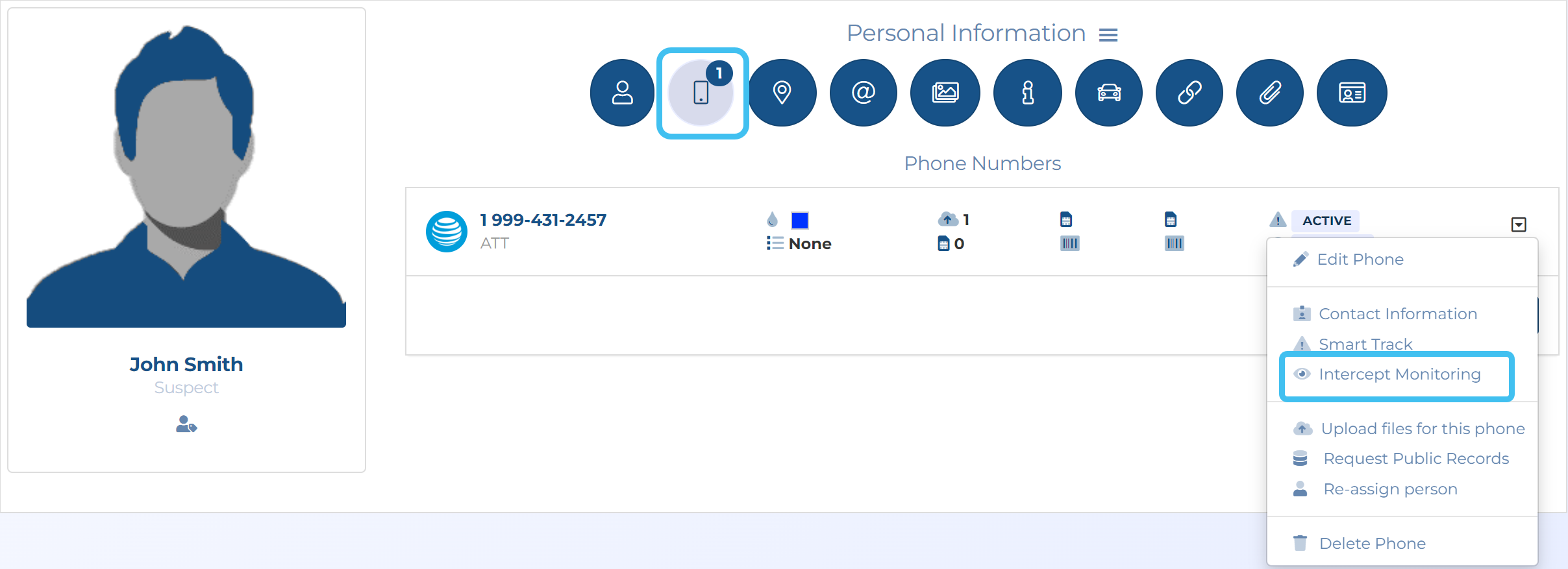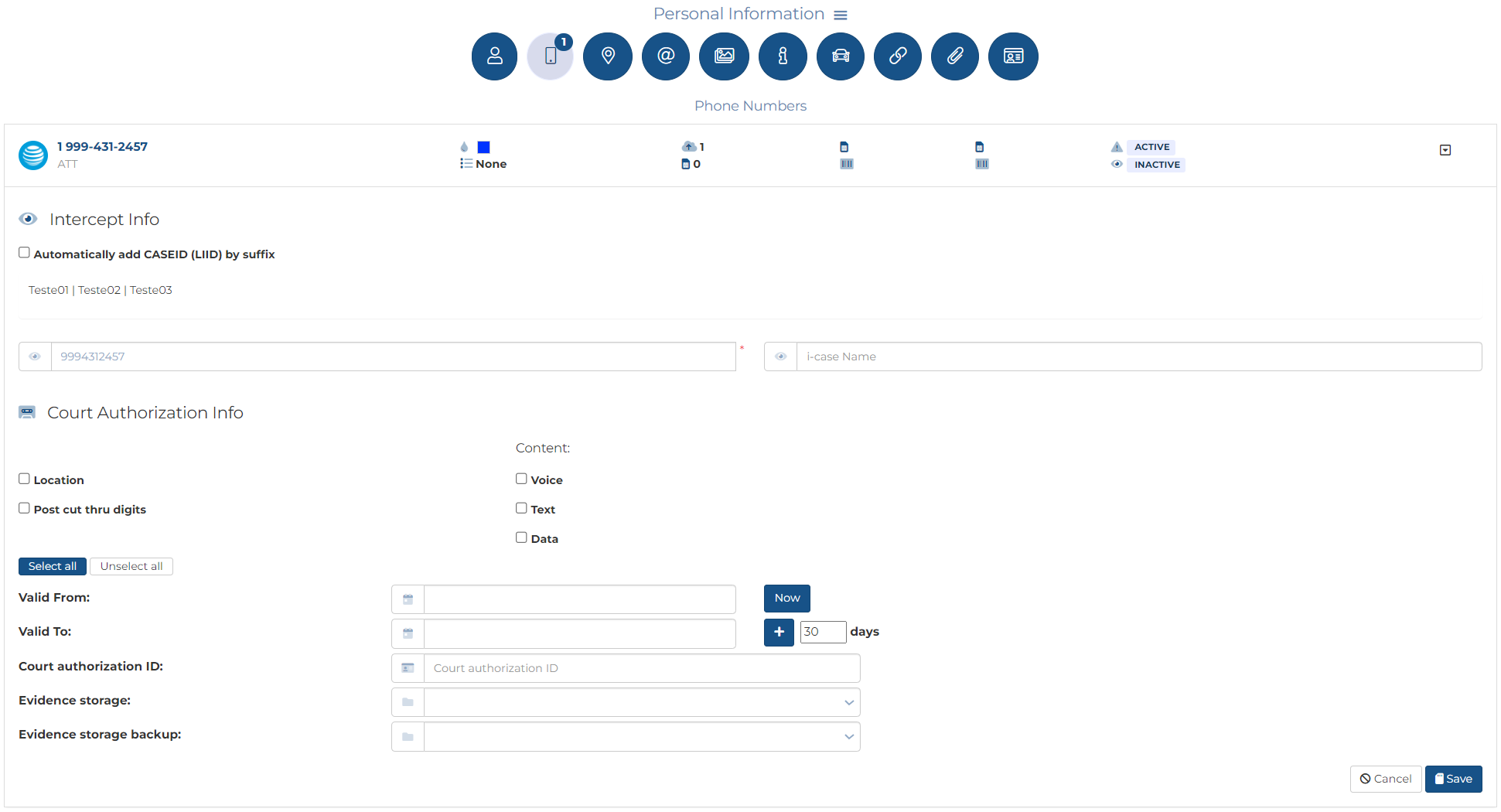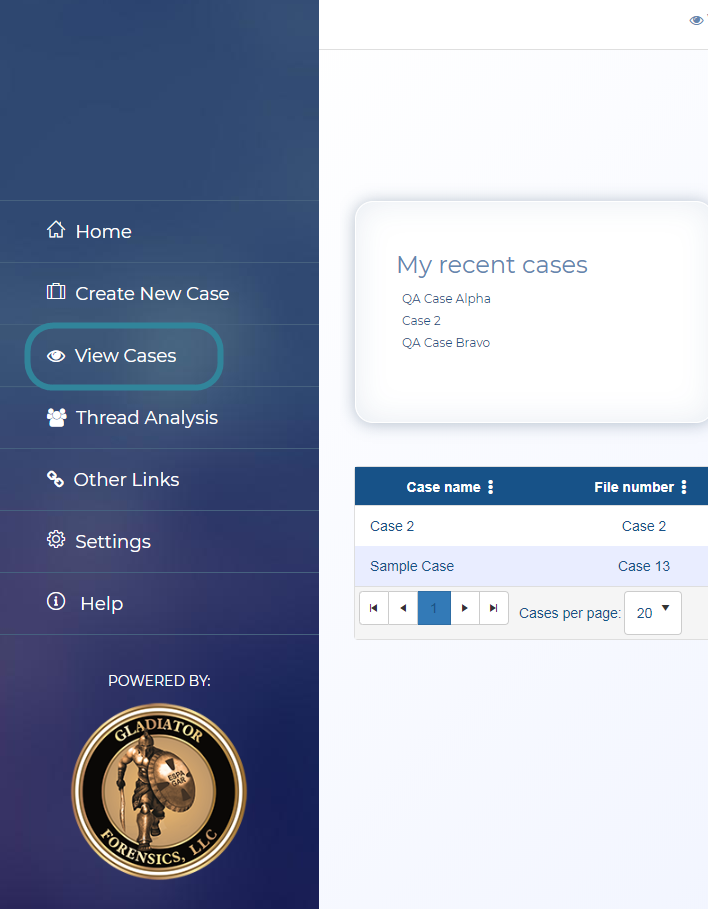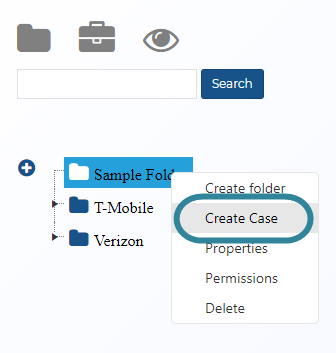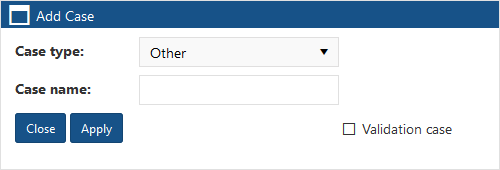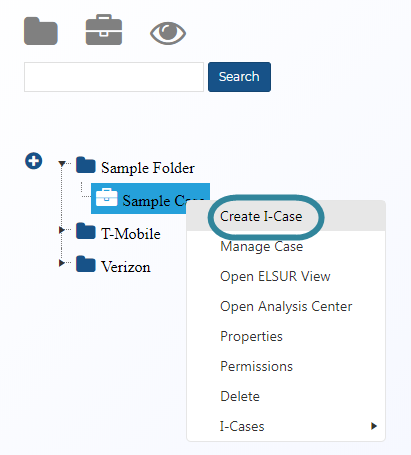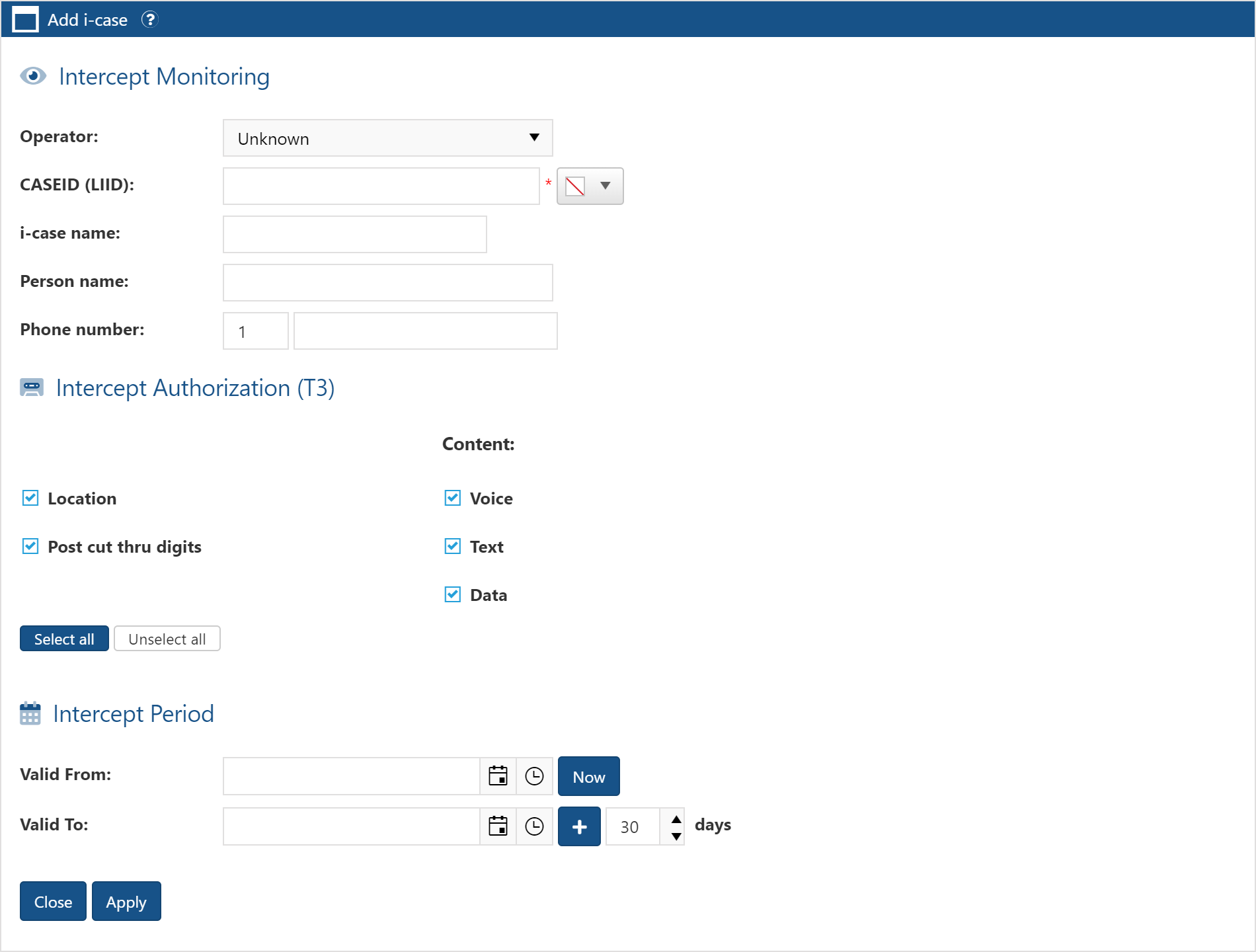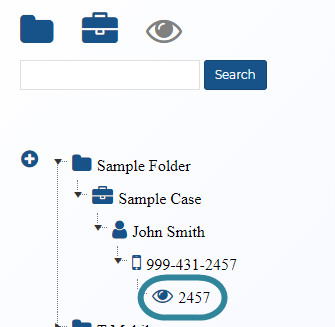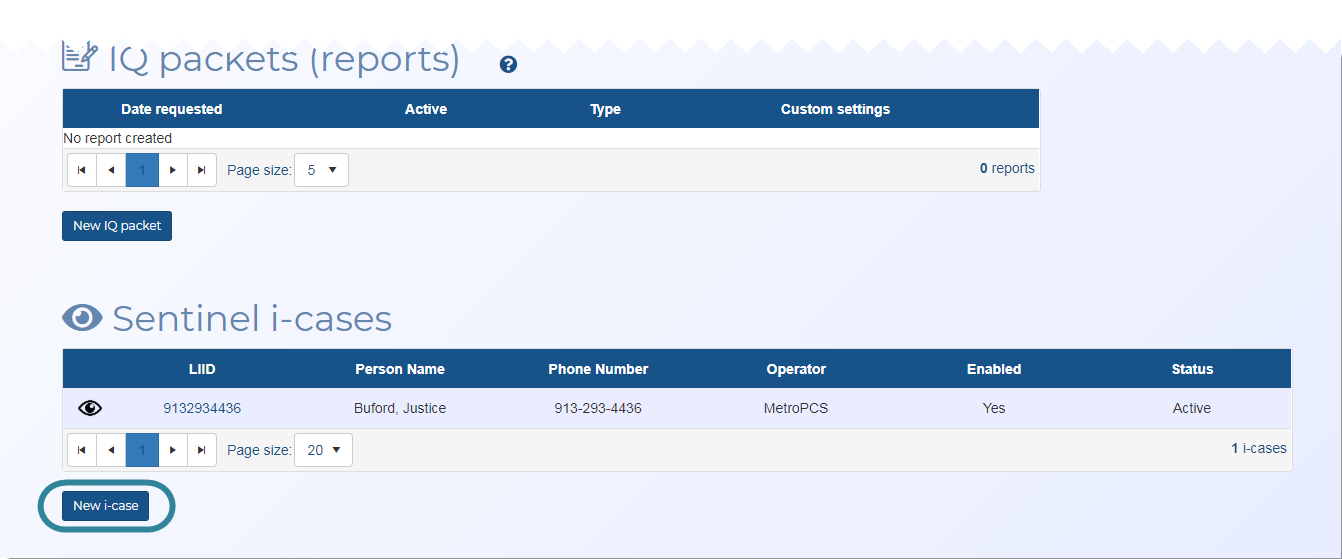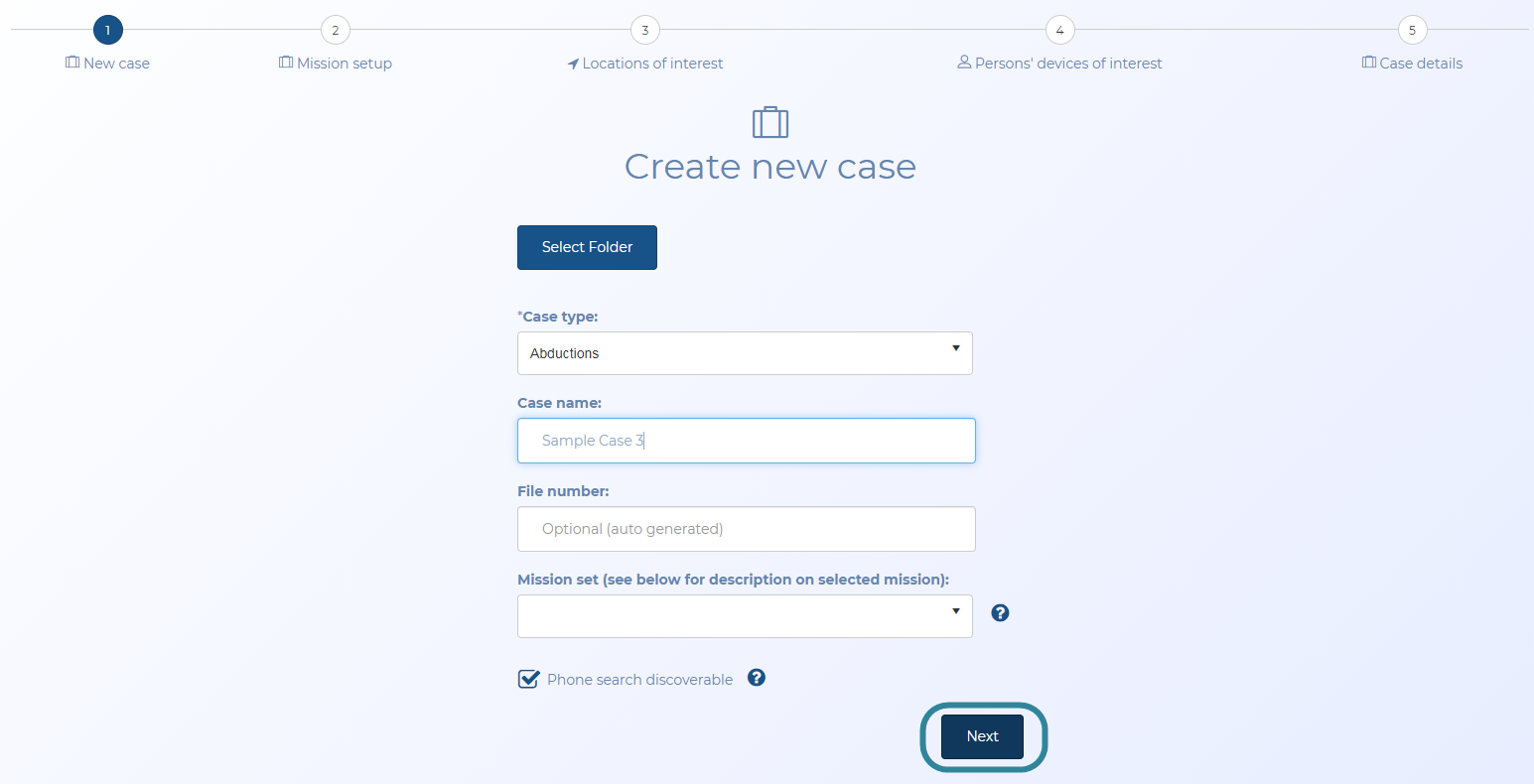Creating a case for intercept monitoring (PRTT and Wiretap)
This topic describes how to create a case for the purposes of intercept monitoring. You can either do this:
- using the View i-cases screen.
- using the Manage case screen.
- using the wizard.
The first procedure, How to set up an intercept on an existing phone, assumes that you already have a case, person and phone available to set up an intercept on. The other procedures take you through the full process of creating a case and intercept.
After creating your case, if you require further information on managing intercept monitoring cases refer to either Managing intercept monitoring case details using the View i-cases screen, or Managing i-cases if you are using the Manage case screen or the wizard.
You can also click here for a short video showing how to create PRTT case. In addition these videos show the Intercept info settings required specifically for ATT and Verizon.
This feature requires option E14 Sentinel. If you do not have this option this feature is not available.
How to set up an intercept on an existing phone
-
For the case you want to add a wiretap to, open the Manage case screen and in the People and device section click their name.
The People and device screen opens.
-
Click
 , then click
, then click  and select Intercept monitoring.
and select Intercept monitoring. -
Click Create i-case.
-
In Intercept info:
-
If your administrator has created suffixes for the selected operator then you have the option on which method you use to enter the CASEID (LIID). If not you can only use the manual option. Either:
- Manually enter the CASEID (LIID):
In CASEID (LIID) enter the lawful interception identifier. This is the only mandatory setting, all others are optional although it is strongly recommended that you also enter a person name and phone number.
- In i-case name enter a name for the i-case if you prefer to use a name rather than the CASEID (LIID). This is then used, rather than the CASEID (LIID), on the OSS-ESPA screens and the G-Scout App to identify the i-case.
- Automatically enter the CASEID (LIID):
Select Automatically add LIID by prefix/suffix.
- In Prefix and Suffix, if available, select the ones you want appended to the phone number.
- Manually enter the CASEID (LIID):
-
-
In Court authorization info:
-
Select Locations if your warrant has authorized cell site locations.
-
Select Post cut thru digits if your warrant has authorized them.
-
If your intercept monitoring is for wiretaps, then in Content select which types of communication content your warrant has authorized. Note, this setting is not applicable for PRTT.
-
In Valid From and Valid To, enter the dates that the CASEID (LIID) is approved for. The monitoring will end when the valid to date expires. You can use the date pickers to select the dates. However, if you want the Valid From date as today's date then click Now and if the monitoring is valid for a specified number of days then select the number of days then click +.
NOTE: These dates are optional. If you do enter them and then subsequently extend the warrant you must update these dates otherwise will OSS-ESPA block the data sent by the operators after the Valid To date.
-
In Court authorization ID enter the search warrant identifier. This is then included in Evidence Management and Reporting.
-
If your intercept monitoring is for wiretaps, then in Evidence storage and Evidence storage backup, select the paths you want used for archiving the case's Sentinel data. Note, this setting is not applicable for PRTT.
-
-
Click Save.
-
To verify your intercept is configured, ensure it displays in the Sentinel i-cases section on the Manage case screen.
When OSS-ESPA receives the first PRTT data or GPS ping from the operator it sends an email to the case creator, case assignees and administrator to notify them that the first alert has been received. The email is titled "First Data <person name> - First Data ALERT". Note, administrators can change who receives these emails using Send "First data alert" notification for administrators and Exclude domains.
-
Click here to create a new case.
Alternatively open the View i-cases screen. It may be that your Home page is configured to open this screen but if not:
-
On the main menu click View Cases.
-
Either the Advanced view cases, View i-cases or the View Cases screen opens depending on your setting of View cases on the User settings screen. If the View Cases or Advanced view cases screens open then click
 at the top-right of the screen to open the View i-cases screen.
at the top-right of the screen to open the View i-cases screen.
-
-
Right-click the folder you want to create your case in, then select Create Case.
The Add Case dialog box opens.
- In Case type select the type of case. This selection simply helps you filter cases in the future on the View Cases screen making them easier to locate. It does not change any subsequent settings.
-
In Case name, although it is optional it is recommended that you enter a name for the case so that the name means something to you, for example "Jewelry Store Robberies". However if you don't, OSS-ESPA will automatically create one which is titled using the format "Case <n>", where <n> is a number which increments each time a user on your OSS-ESPA account selects to automatically generate a case name.
-
Click Apply.
The dialog box closes and the case is created within the folder you selected.
-
Right-click the case you just created and select Create i-case.
The Add i-case dialog box opens.
-
In Intercept monitoring:
-
In Person name enter the person's names. Although this is optional it is strongly recommended that you structure your i-case to a person and their phone number.
-
In Phone number enter the country code and the phone number. Although this is optional it is strongly recommended that you structure your i-case to a person and their phone number.
NOTE: If you do not add a Person name but do enter a Phone number then the phone number is automatically used to populate the Person name.
-
In Operator select the phone number's service provider.
-
If your administrator has created suffixes for the selected operator then you have the option on which method you use to enter the CASEID (LIID). If not you can only use the manual option. Either:
- Manually enter the CASEID (LIID):
In CASEID (LIID) enter the lawful interception identifier. This is the only mandatory setting, all others are optional although it is strongly recommended that you also enter a person name and phone number.
- In i-case name enter a name for the i-case if you prefer to use a name rather than the CASEID (LIID). This is then used, rather than the CASEID (LIID), on the OSS-ESPA screens and the G-Scout App to identify the i-case.
- Automatically enter the CASEID (LIID):
Select Automatically add LIID by prefix/suffix.
- In Prefix and Suffix, if available, select the ones you want appended to the phone number.
- Manually enter the CASEID (LIID):
-
-
In Court authorization info:
-
Select Locations if your warrant has authorized cell site locations.
-
Select Post cut thru digits if your warrant has authorized them.
-
If your intercept monitoring is for wiretaps, then in Content select which types of communication content your warrant has authorized. Note, this setting is not applicable for PRTT.
-
In Valid From and Valid To, enter the dates that the CASEID (LIID) is approved for. The monitoring will end when the valid to date expires. You can use the date pickers to select the dates. However, if you want the Valid From date as today's date then click Now and if the monitoring is valid for a specified number of days then select the number of days then click +.
NOTE: These dates are optional. If you do enter them and then subsequently extend the warrant you must update these dates otherwise will OSS-ESPA block the data sent by the operators after the Valid To date.
-
In Court authorization ID enter the search warrant identifier. This is then included in Evidence Management and Reporting.
-
If your intercept monitoring is for wiretaps, then in Evidence storage and Evidence storage backup, select the paths you want used for archiving the case's Sentinel data. Note, this setting is not applicable for PRTT.
-
-
Click Apply. The dialog boxes closes and the i-case is added to your case.
When OSS-ESPA receives the first PRTT data or GPS ping from the operator it sends an email to the case creator, case assignees and administrator to notify them that the first alert has been received. The email is titled "First Data <person name> - First Data ALERT". Note, administrators can change who receives these emails using Send "First data alert" notification for administrators and Exclude domains.
-
Click here to create a new case.
Alternatively on the main menu click Create new case then select Without wizard. The Create new case screen opens.
- Click Select Folder to open the Select a Folder dialog box and define which folder you want your case created in. These folders are defined by your administrator.
- In Case type select the type of case. This selection simply helps you filter cases in the future on the View Cases screen making them easier to locate. It does not change any subsequent settings.
-
In Case name, although it is optional it is recommended that you enter a name for the case so that the name means something to you, for example "Jewelry Store Robberies". However if you don't, OSS-ESPA will automatically create one which is titled using the format "Case <n>", where <n> is a number which increments each time a user on your OSS-ESPA account selects to automatically generate a case name.
-
Ensure Enable deconfliction (X-Case data search) is selected if you want the case data to be visible and usable for all account users if they do an identifier search for an identifier that occurs in your case. Identifiers can be phone numbers, IMSI, IMEI, names, license plates, and social media accounts. For further information refer to Enable deconfliction (X-Case data search) .
- There is no need to select a mission set.
-
Click Next.
Your case is created and the Manage case screen opens.
-
Click New i-case above the Sentinel i-cases section.
The Sentinel i-cases screen opens.
-
In Intercept monitoring:
-
In Person name enter the person's names. Although this is optional it is strongly recommended that you structure your i-case to a person and their phone number.
-
In Phone number enter the country code and the phone number. Although this is optional it is strongly recommended that you structure your i-case to a person and their phone number.
NOTE: If you do not add a Person name but do enter a Phone number then the phone number is automatically used to populate the Person name.
-
In Operator select the phone number's service provider.
-
If your administrator has created suffixes for the selected operator then you have the option on which method you use to enter the CASEID (LIID). If not you can only use the manual option. Either:
- Manually enter the CASEID (LIID):
In CASEID (LIID) enter the lawful interception identifier. This is the only mandatory setting, all others are optional although it is strongly recommended that you also enter a person name and phone number.
- In i-case name enter a name for the i-case if you prefer to use a name rather than the CASEID (LIID). This is then used, rather than the CASEID (LIID), on the OSS-ESPA screens and the G-Scout App to identify the i-case.
- Automatically enter the CASEID (LIID):
Select Automatically add LIID by prefix/suffix.
- In Prefix and Suffix, if available, select the ones you want appended to the phone number.
- Manually enter the CASEID (LIID):
-
-
In Court authorization info:
-
Select Locations if your warrant has authorized cell site locations.
-
Select Post cut thru digits if your warrant has authorized them.
-
If your intercept monitoring is for wiretaps, then in Content select which types of communication content your warrant has authorized. Note, this setting is not applicable for PRTT.
-
In Valid From and Valid To, enter the dates that the CASEID (LIID) is approved for. The monitoring will end when the valid to date expires. You can use the date pickers to select the dates. However, if you want the Valid From date as today's date then click Now and if the monitoring is valid for a specified number of days then select the number of days then click +.
NOTE: These dates are optional. If you do enter them and then subsequently extend the warrant you must update these dates otherwise will OSS-ESPA block the data sent by the operators after the Valid To date.
-
In Court authorization ID enter the search warrant identifier. This is then included in Evidence Management and Reporting.
-
If your intercept monitoring is for wiretaps, then in Evidence storage and Evidence storage backup, select the paths you want used for archiving the case's Sentinel data. Note, this setting is not applicable for PRTT.
-
- Click Add. If required you can repeat the above steps to add additional i-cases to the table.
-
Click Save.
The Manage case screen opens and the i-case you added is displayed in the Sentinel i-cases group.
When OSS-ESPA receives the first PRTT data or GPS ping from the operator it sends an email to the case creator, case assignees and administrator to notify them that the first alert has been received. The email is titled "First Data <person name> - First Data ALERT". Note, administrators can change who receives these emails using Send "First data alert" notification for administrators and Exclude domains.
-
Click here to create a new case.
Alternatively on the main menu click Create new case then With Wizard. The Create new case screen opens.
- Click Select Folder to open the Select a Folder dialog box and define which folder you want your case created in. These folders are defined by your administrator.
- In Case type select the type of case. This selection simply helps you filter cases in the future on the View Cases screen making them easier to locate. It does not change any subsequent settings.
-
In Case name, although it is optional it is recommended that you enter a name for the case so that the name means something to you, for example "Jewelry Store Robberies". However if you don't, OSS-ESPA will automatically create one which is titled using the format "Case <n>", where <n> is a number which increments each time a user on your OSS-ESPA account selects to automatically generate a case name.
-
Ensure Enable deconfliction (X-Case data search) is selected if you want the case data to be visible and usable for all account users if they do an identifier search for an identifier that occurs in your case. Identifiers can be phone numbers, IMSI, IMEI, names, license plates, and social media accounts. For further information refer to Enable deconfliction (X-Case data search) .
-
Click Next.
The Mission setup screen opens.
- Click Intercept Monitoring to display the settings.
-
In Intercept monitoring:
-
In Person name enter the person's names. Although this is optional it is strongly recommended that you structure your i-case to a person and their phone number.
-
In Phone number enter the country code and the phone number. Although this is optional it is strongly recommended that you structure your i-case to a person and their phone number.
NOTE: If you do not add a Person name but do enter a Phone number then the phone number is automatically used to populate the Person name.
-
In Operator select the phone number's service provider.
-
If your administrator has created suffixes for the selected operator then you have the option on which method you use to enter the CASEID (LIID). If not you can only use the manual option. Either:
- Manually enter the CASEID (LIID):
In CASEID (LIID) enter the lawful interception identifier. This is the only mandatory setting, all others are optional although it is strongly recommended that you also enter a person name and phone number.
- In i-case name enter a name for the i-case if you prefer to use a name rather than the CASEID (LIID). This is then used, rather than the CASEID (LIID), on the OSS-ESPA screens and the G-Scout App to identify the i-case.
- Automatically enter the CASEID (LIID):
Select Automatically add LIID by prefix/suffix.
- In Prefix and Suffix, if available, select the ones you want appended to the phone number.
- Manually enter the CASEID (LIID):
-
-
In Court authorization info:
-
Select Locations if your warrant has authorized cell site locations.
-
Select Post cut thru digits if your warrant has authorized them.
-
If your intercept monitoring is for wiretaps, then in Content select which types of communication content your warrant has authorized. Note, this setting is not applicable for PRTT.
-
In Valid From and Valid To, enter the dates that the CASEID (LIID) is approved for. The monitoring will end when the valid to date expires. You can use the date pickers to select the dates. However, if you want the Valid From date as today's date then click Now and if the monitoring is valid for a specified number of days then select the number of days then click +.
NOTE: These dates are optional. If you do enter them and then subsequently extend the warrant you must update these dates otherwise will OSS-ESPA block the data sent by the operators after the Valid To date.
-
In Court authorization ID enter the search warrant identifier. This is then included in Evidence Management and Reporting.
-
If your intercept monitoring is for wiretaps, then in Evidence storage and Evidence storage backup, select the paths you want used for archiving the case's Sentinel data. Note, this setting is not applicable for PRTT.
-
- Click Add. If required you can repeat the above steps to add additional i-cases to the table.
-
Click Next if you want to continue and add optional locations and optional further person details to the case but if not click Exit.
The Manage case screen opens and the i-case you added is displayed in the Sentinel i-cases group.
When OSS-ESPA receives the first PRTT data or GPS ping from the operator it sends an email to the case creator, case assignees and administrator to notify them that the first alert has been received. The email is titled "First Data <person name> - First Data ALERT". Note, administrators can change who receives these emails using Send "First data alert" notification for administrators and Exclude domains.
